Whether it’s food, beverages, or pet products, the drop in temperature can affect product integrity and quality. One solution that consistently meets these challenges is flexible packaging.
This innovative approach to packaging is designed not only for convenience and sustainability but also for maintaining the freshness and quality of products during the chilly winter months.
Here’s how flexible packaging helps keep products fresh even when temperatures plummet.
Flexible packaging is equipped with high-barrier materials, such as multi-layer films, that protect products from moisture, oxygen, and temperature changes. During winter, cold and fluctuating conditions can expose products to condensation or freezing. This could compromise their texture, flavour, or nutritional value. The barriers in flexible packaging shield the contents from such exposure. This ensures the product remains fresh and intact until it reaches the consumer’s hands.
Certain flexible packaging solutions are designed to withstand temperature extremes. In cold climates, flexible pouches or films maintain their integrity, avoiding brittleness or cracking, unlike some rigid packaging alternatives that may become brittle and break when exposed to cold weather. This resilience is crucial for maintaining the freshness of food and beverages, especially in transit or storage in unheated areas.
Frozen Foods
For products like frozen foods or items that need refrigeration, freezer burn can significantly affect quality. Flexible packaging can minimise the risk of freezer burn by creating a tight seal that reduces air exposure and evaporation, common culprits of this issue. A well-sealed, flexible package keeps moisture inside the product, ensuring that it retains its intended taste and texture throughout the colder months.
Winter doesn’t just bring cold temperatures; it often slows down supply chains, meaning products may stay in transit or storage for longer periods. Flexible packaging helps extend the shelf life of products by using materials that maintain product freshness over time. For perishable goods like fresh food, pet food, or nutritional supplements, this extended shelf life is crucial for maintaining consumer trust and satisfaction.
Sustainability
While keeping products fresh is a top priority, flexible packaging is also a sustainable choice. Many flexible packaging materials are designed with recyclability in mind, reducing waste and minimising environmental impact. This is especially important during winter months when energy consumption tends to rise. Using eco-friendly packaging helps companies stay committed to sustainability even when cold weather demands more from supply chains.
Winter months can pose challenges for transportation and storage, as space becomes more limited and temperatures drop. Flexible packaging is lightweight and easy to store, reducing the need for extra packaging material and minimising shipping costs. Additionally, it takes up less space in transportation vehicles. This allows more products to be shipped in a single trip, reducing overall environmental impact and keeping the cold-chain logistics efficient.
If your brand wants to invest in quality packaging, we will guide you through the entire print process. In addition, we are providing recommendations along the way to improve efficiency, reduce costs and add untold value to the end product.
Contact us on +44 (0) 161 440 7302 or follow this link to complete our contact form – or, we’ll see you there!


